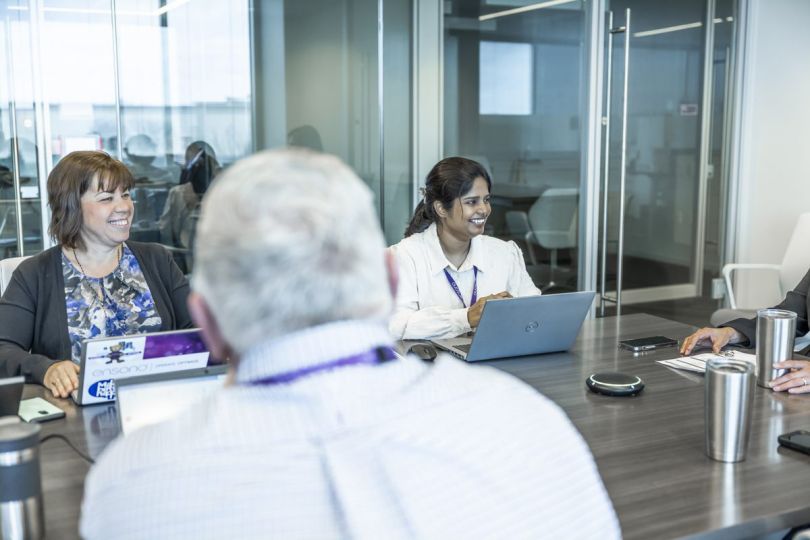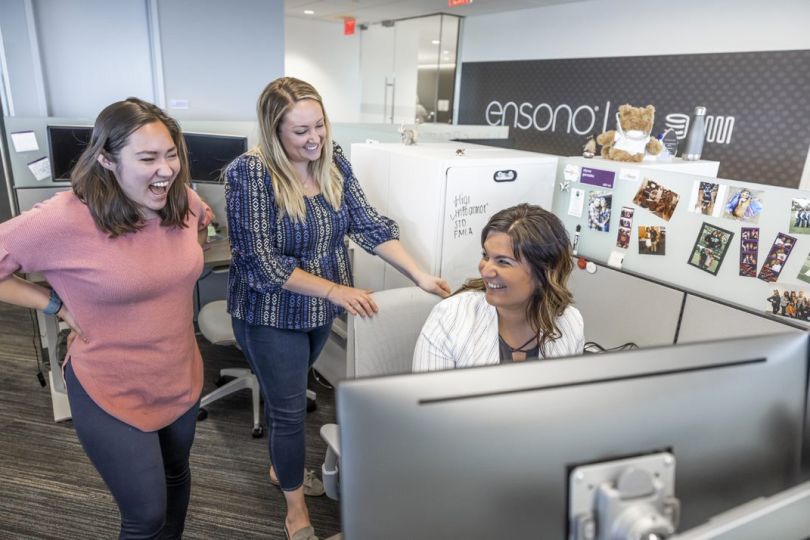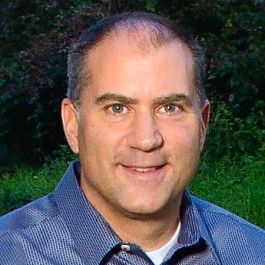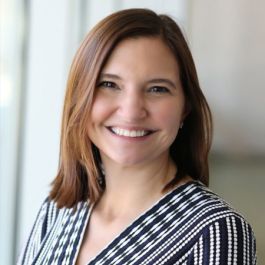A row of uniform binders might make for a handsome Zoom background, but in today’s world, that might be all they’re good for — even when they contain a company’s five-year roadmap.
After two decades of working in tech, Jeff Wile has encountered a lot of these binders, given to his team by various consulting groups.
“In many cases, those plans just became really pretty binders that sat on a shelf,” Wile said. “They cost a whole lot of money but the ideas were never implemented.”
After all, technology changes so rapidly that a static five-year plan can quickly become out of date. And for enterprise companies, enacting widespread change can be a slow process. It’s little wonder that, when faced with an enormous list of new technology and methodologies, established teams might become paralyzed by outside recommendations altogether.
But there’s a more effective way to guide businesses as they modernize their tech stack and streamline new processes. Wile has seen it first hand in his role as an executive vice president at Ensono, a company that specializes in helping IT teams embrace new services and technology.
“We’re of the mindset that if we can pick an area that’s small, execute on that and show value, we can then grow into the next area,” Wile said. “It’s a much better approach than mapping out what the next few years could look like. We’re going to actually do real work and deliver immediate value, and customers can see that we’ve made progress. That’s an important part of how we build our business.”
And for Ensono, business is picking up. As enterprise companies increasingly look to overhaul their legacy systems, consulting groups are playing a significant role in setting the tone for modernization efforts — especially those with expertise in cutting-edge technology.
“The work is up for grabs,” Bikram Singh, a vice president at Ensono, said. “Either we do it, or someone else is going to take it from us.”
Unwilling for that to happen, Ensono has been assembling Ensono Digital, a new team designed to tackle customers’ digital transformation efforts through building cloud-native capabilities, harnessing modern architectures like microservices, event-driven and more. To create quick impact, Ensono acquired a cloud company based in the United Kingdom in 2021, and is looking to hire more tech talent to further its vision.
“Where Ensono has traditionally excelled has been through helping companies run their legacy systems to be as efficient as possible,” Wile said. “Now, with Ensono Digital, we can still help companies with their legacy systems, but also modernize their applications and build new ones that will drive business forward in a way that’s cloud native and leverages new technologies.”
To learn more about the creation of Ensono Digital, Built In connected with Wile, Singh and Chief People Officer Meredith Graham. Together, they filled us in on what the future holds for the team, the rich career growth opportunities available and why a role at the company means talent will never be bored.

What’s your background? What attracted you to Ensono Digital?
Executive Vice President, Ensono Digital Jeff Wile: I started my technology journey in the service provider world, helping companies operate efficiently as the internet was launching. One of my customers at the time ended up taking a chief technology officer role at a division of Disney and asked me to come over and help transition the company to the cloud. I stayed there from 2009 to 2017 and then took my playbook to Starbucks to help it through its digital transformation. I spent about three years working on their infrastructure operations and cloud strategy before leading the customer-facing engineering teams in building applications as the chief information officer.
I realized that the further I got in my career, the less time I got to spend on actually solving cool problems in technology. And while I enjoyed helping Disney and Starbucks, I remembered what it was like to help lots of companies as a service provider. I wanted to take the lessons I’d learned at these giant organizations and help other companies through their digital transformations. That’s what gets me out of bed in the morning and it’s what I’m passionate about.
Vice President Ensono Digital Bikram Singh: Previously, I spent some time at Cisco, and then at IBM as an advisory consultant. Before Ensono, I was at a small cloud advisory and consulting firm called Intuitive Technology Partners, where I led the public cloud advisory and consulting practice. The reason I picked Ensono is that I had been with the same group of people doing the same set of things, and I was too comfortable.
My experience has been as a person who acts as a bridge between legacy footprint and modern technology. Enterprise companies move slowly because of how big they are, and because they have so much data and compliance they have to observe. Modernization efforts from legacy to modern architectures and cloud-native technologies can take some time. I know how old-school legacy technology and new tech works, and I can articulate this to both sides — the customer and my team — effectively.
Chief People Officer Meredith Graham: I’ve been at Ensono for nearly seven years. I started when we were a small spin-off group focused on providing mainframe and some infrastructure services. It was a great time to focus on what technologies we should be offering to different clients, expanding our product portfolio and building a great culture. Since then, we’ve grown rapidly. It’s been exciting to come to work every day and do something you know is providing an impact on your clients.
What are you working on right now?
Wile: We work on a relatively broad spectrum of projects. We’re currently building really cool new capabilities for a next-generation e-commerce platform for a very large retailer. We’re also building a next-generation loyalty and customer platform for one of the largest fitness companies in the industry. We’re doing some significant data platform work as well, so clients can get the right customer data to communicate in a more targeted way.
We’re seeing a lot of organizations that have a large number of applications they want to modernize. What these companies are finding is that managing and running operations in the cloud is very different than using data centers and network, storage and compute teams. They need a partner to help them figure out what the future looks like and what the right solutions are for them. The challenge is that helping each customer is different — which gives us a lot of flexibility, but it isn’t plug and play from a solutions perspective.
The real value of cloud technology
What are some of the challenges in building out a new team like Ensono Digital?
Graham: We’re in the war for talent. We’re looking for talent that can marry the cloud experience with consulting. But what gets people excited about Ensono is that they’re going to be on the ground floor of something that they can help build, versus going to a company that’s already established with processes.
Ensono was lucky enough to find Amido, a company in the United Kingdom, that was right in the wheelhouse of what we were looking to build. We acquired the company last spring and are now looking at bringing that service to the United States. There are some people coming over from the United Kingdom to help us, and we’re also building up the talent that we already have to build new services for our clients in the United States.

What do you look for when hiring new team members?
Singh: When I look for new team members, I look first at attitude. It’s impossible to judge someone in 30 to 45 minutes, but sometimes based on their track record and what they want to do, you can predict their ability to change and adapt. I also look for people’s base skillsets. I don’t look at a checklist where everyone has to know 100 percent of every technology, but I want to see that the person has a foundational knowledge to get started and that they’re a self-learner, coachable and trainable. Finally, I would not hire someone who cannot collaborate or be part of the team.
Wile: One of the things I look for when I hire is if a person is curious. Do they ask questions and try to figure out how things work? Are they interested in a variety of different topics? It points to someone being well-rounded, even outside of technology. I also look for people who are willing to try new things. They might fail, but that’s OK because that’s a part of learning. I think those are the only ways you can embrace constant change and live in the middle of it. In this line of work, you might master a tool, and then a year later something better comes out. You have to be able to say, “Well, now I know two ways to solve this problem.”
Protected time to learn
What does career growth look like at Ensono?
Graham: People come to Ensono for career development and that’s why they stay here. We have career paths that lead to leadership, but because we work with such a broad array of technologies, we also have lateral moves that many other companies can’t offer. There are so many opportunities to learn, grow and step into new roles within the company. We are developing a self-service model around career development, where people can see what roles are available and the competencies they’d need. Then, they can use our online training tools to get there.
We have a lot of great academies for our established lines of business, such as our mainframe and public cloud programs. There’s been a lot of internal movement because of these programs. Because Ensono Digital is so new, we’re still mapping out what a training and development program would look like for existing talent interested in moving into this part of the organization. We’re aiming to have clear career paths and roadmaps for the team by the end of the year because we think creating learning opportunities and career paths is invaluable.
Why is now a good time for technologists to join your team?
Singh: We’re working on modern technology that will drive our business for the next couple of years. We are open to upskill trained people, because there’s not one type of technology we use. We don’t build silos where, if you’re working on AWS, you’re likely not going to work on AWS forever. There will be opportunities to cross train where you might learn Microsoft, then you may learn Snowflake. That’s the culture we’re trying to build: one that allows everyone to collaborate, learn and grow.
Wile: One of the beauties of working for a consulting and service provider organization is the variety of opportunities and challenges you are presented with. For example, you could be working on the AWS platform for one client for a few months and your next client might be on the Azure or Google platform.
There’s a tremendous amount of learning you can do here, if you’re up for it. If you’re curious about technology, there’s no better place to try on a bunch of different hats. If there’s a specialty you’re really interested in, whether it’s data, user experience or cloud-services work, you can very much find your specialty. If you want to go broad or you want to go deep, we can facilitate that.







